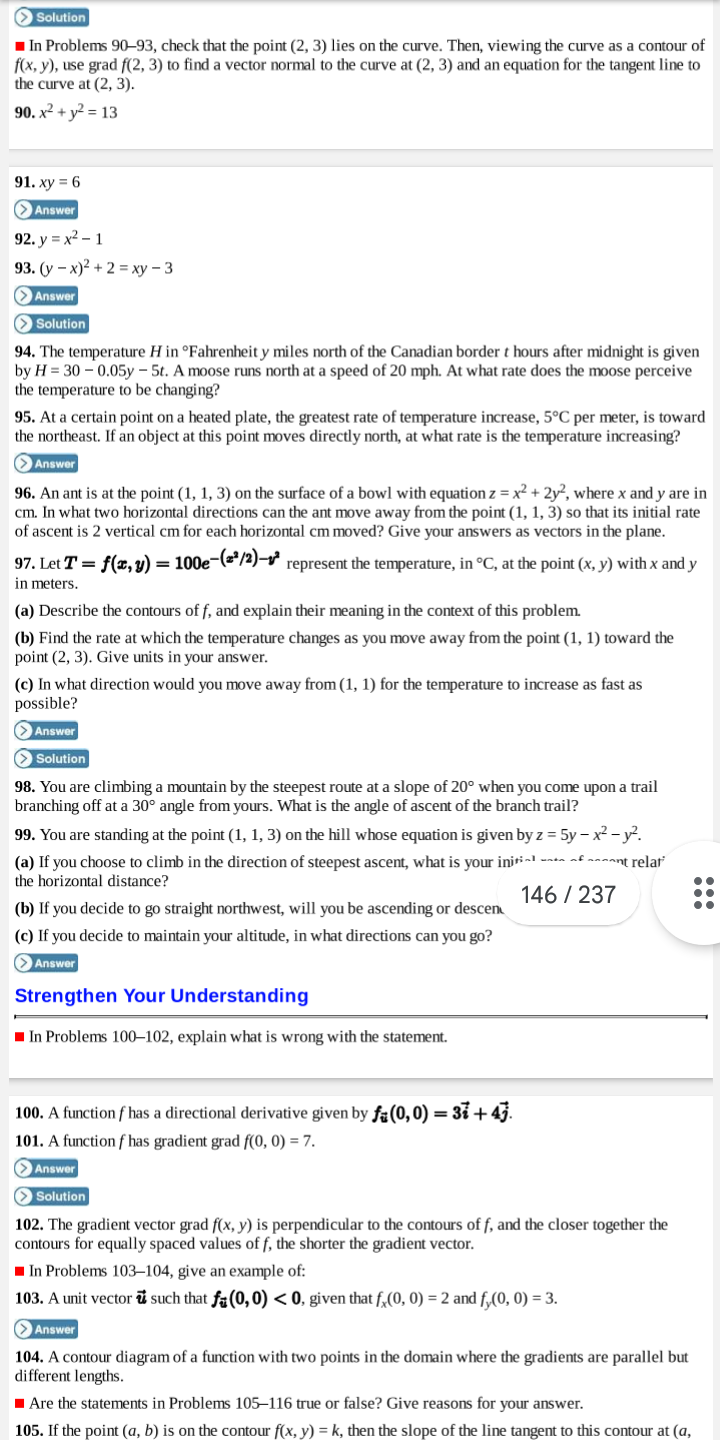96. An ant is at the point (1, 1, 3) on the surface of a bowl with equation z = x² + 2y², where x and y are in |cm. In what two horizontal directions can the ant move away from the point (1, 1, 3) so that its initial rate of ascent is 2 vertical cm for each horizontal cm moved? Give your answers as vectors in the plane.
96. An ant is at the point (1, 1, 3) on the surface of a bowl with equation z = x² + 2y², where x and y are in |cm. In what two horizontal directions can the ant move away from the point (1, 1, 3) so that its initial rate of ascent is 2 vertical cm for each horizontal cm moved? Give your answers as vectors in the plane.
Advanced Engineering Mathematics
10th Edition
ISBN:9780470458365
Author:Erwin Kreyszig
Publisher:Erwin Kreyszig
Chapter2: Second-order Linear Odes
Section: Chapter Questions
Problem 1RQ
Related questions
Question
Please solve question no 96

Transcribed Image Text:Solution
I In Problems 90–93, check that the point (2, 3) lies on the curve. Then, viewing the curve as a contour of
f(x, y), use grad f(2, 3) to find a vector normal to the curve at (2, 3) and an equation for the tangent line to
the curve at (2, 3).
90. x² + y² = 13
91. ху %3D6
Answer
92. y = x2 – 1
93. (у — х)2 + 2 %3 ху — 3
>
Answer
> Solution
94. The temperature H in °Fahrenheit y miles north of the Canadian border t hours after midnight is given
by H = 30 – 0.05y – 5t. A moose runs north at a speed of 20 mph. At what rate does the moose perceive
the temperature to be changing?
95. At a certain point on a heated plate, the greatest rate of temperature increase, 5°C per meter, is toward
the northeast. If an object at this point moves directly north, at what rate is the temperature increasing?
O Answer
96. An ant is at the point (1, 1, 3) on the surface of a bowl with equation z = x² + 2y², where x and y are in
cm. In what two horizontal directions can the ant move away from the point (1, 1, 3) so that its initial rate
of ascent is 2 vertical cm for each horizontal cm moved? Give your answers as vectors in the plane.
97. Let T = f(x, y) = 100e-(="/2)–v represent the temperature, in °C, at the point (x, y) with x and y
in meters.
(a) Describe the contours of f, and explain their meaning in the context of this problem.
(b) Find the rate at which the temperature changes as you move away from the point (1, 1) toward the
point (2, 3). Give units in your answer.
(c) In what direction would you move away from (1, 1) for the temperature to increase as fast as
possible?
> Answer
>
Solution
98. You are climbing a mountain by the steepest route at a slope of 20° when you come upon a trail
branching off at a 30° angle from yours. What is the angle of ascent of the branch trail?
99. You are standing at the point (1, 1, 3) on the hill whose equation is given by z = 5y – x² - y².
(a) If you choose to climb in the direction of steepest ascent, what is your inisi-
the horizontal distance?
-nta af naeant relat
146 / 237
(b) If you decide to go straight northwest, will you be ascending or descen
(c) If you decide to maintain your altitude, in what directions can you go?
(> Answer
Strengthen Your Understanding
1 In Problems 100–102, explain what is wrong with the statement.
100. A function f has a directional derivative given by f:(0,0) = 31 +43.
101. A function f has gradient grad f(0, 0) = 7.
Answer
> Solution
102. The gradient vector grad f(x, y) is perpendicular to the contours of f, and the closer together the
contours for equally spaced values of f, the shorter the gradient vector.
1 In Problems 103–104, give an example of:
103. A unit vector i such that fa(0,0) < 0, given that f,(0, 0) = 2 and f,(0, 0) = 3.
> Answer
104. A contour diagram of a function with two points in the domain where the gradients are parallel but
different lengths.
I Are the statements in Problems 105–116 true or false? Give reasons for your answer.
105. If the point (a, b) is on the contour f(x, y) = k, then the slope of the line tangent to this contour at (a,
:::
Expert Solution
This question has been solved!
Explore an expertly crafted, step-by-step solution for a thorough understanding of key concepts.
This is a popular solution!
Trending now
This is a popular solution!
Step by step
Solved in 2 steps with 2 images

Recommended textbooks for you

Advanced Engineering Mathematics
Advanced Math
ISBN:
9780470458365
Author:
Erwin Kreyszig
Publisher:
Wiley, John & Sons, Incorporated

Numerical Methods for Engineers
Advanced Math
ISBN:
9780073397924
Author:
Steven C. Chapra Dr., Raymond P. Canale
Publisher:
McGraw-Hill Education

Introductory Mathematics for Engineering Applicat…
Advanced Math
ISBN:
9781118141809
Author:
Nathan Klingbeil
Publisher:
WILEY

Advanced Engineering Mathematics
Advanced Math
ISBN:
9780470458365
Author:
Erwin Kreyszig
Publisher:
Wiley, John & Sons, Incorporated

Numerical Methods for Engineers
Advanced Math
ISBN:
9780073397924
Author:
Steven C. Chapra Dr., Raymond P. Canale
Publisher:
McGraw-Hill Education

Introductory Mathematics for Engineering Applicat…
Advanced Math
ISBN:
9781118141809
Author:
Nathan Klingbeil
Publisher:
WILEY

Mathematics For Machine Technology
Advanced Math
ISBN:
9781337798310
Author:
Peterson, John.
Publisher:
Cengage Learning,

